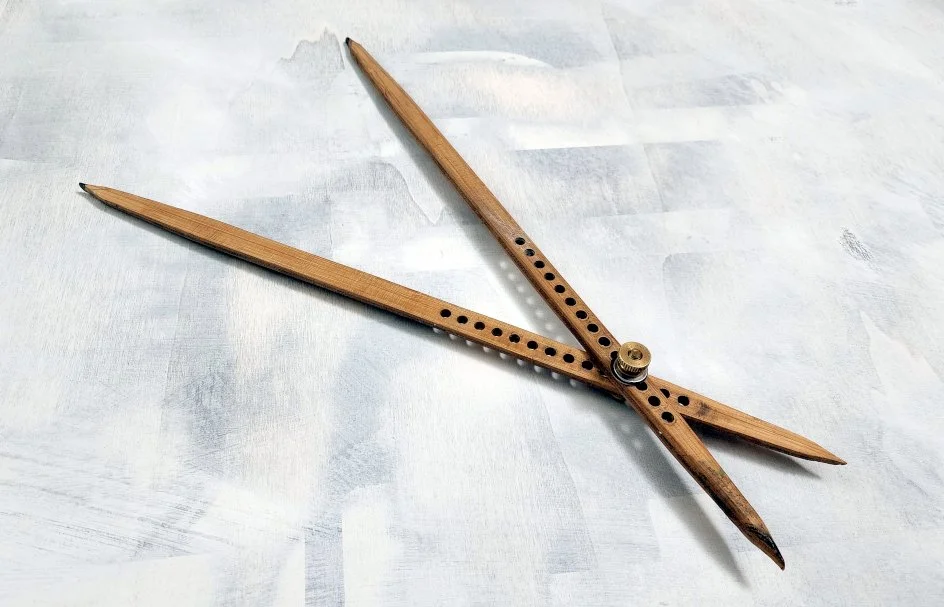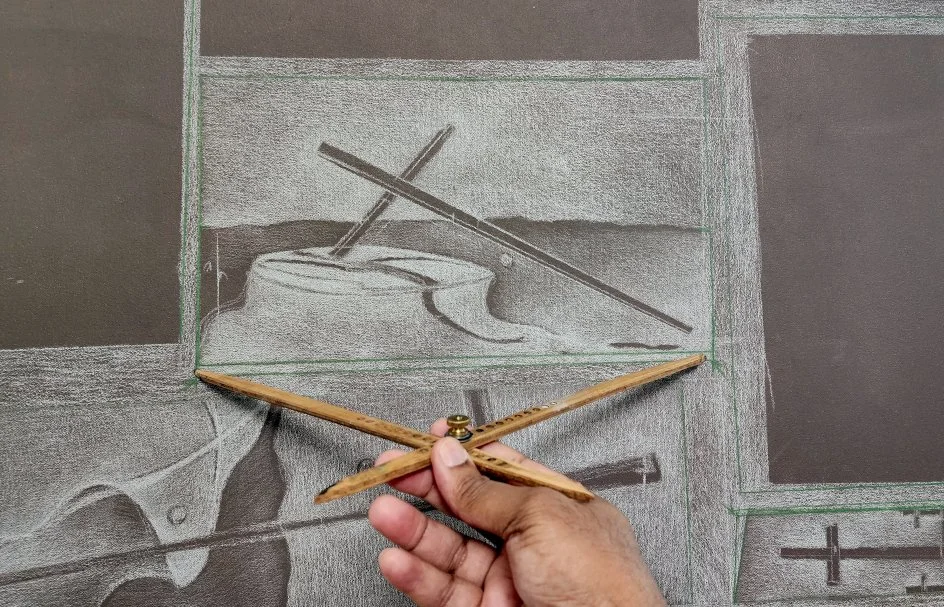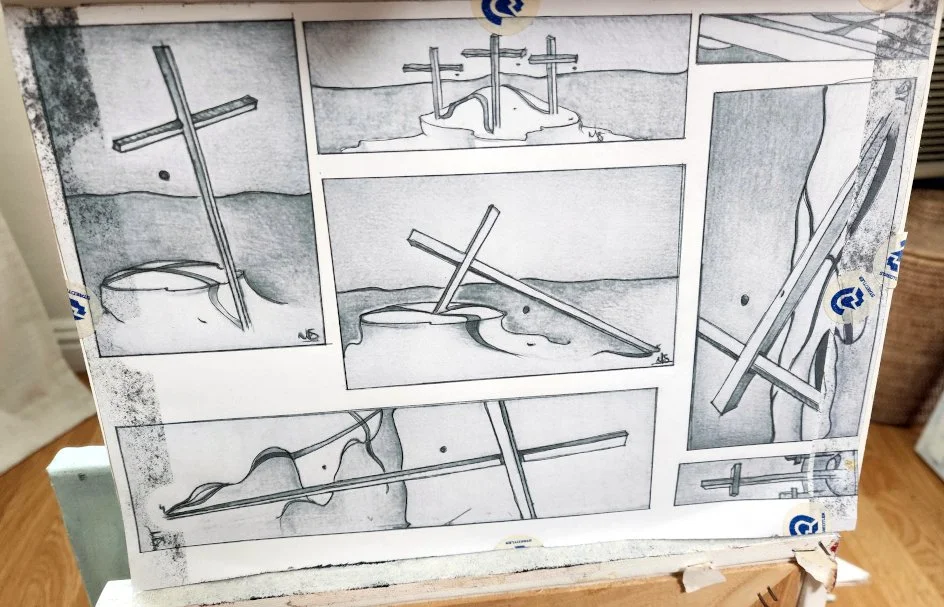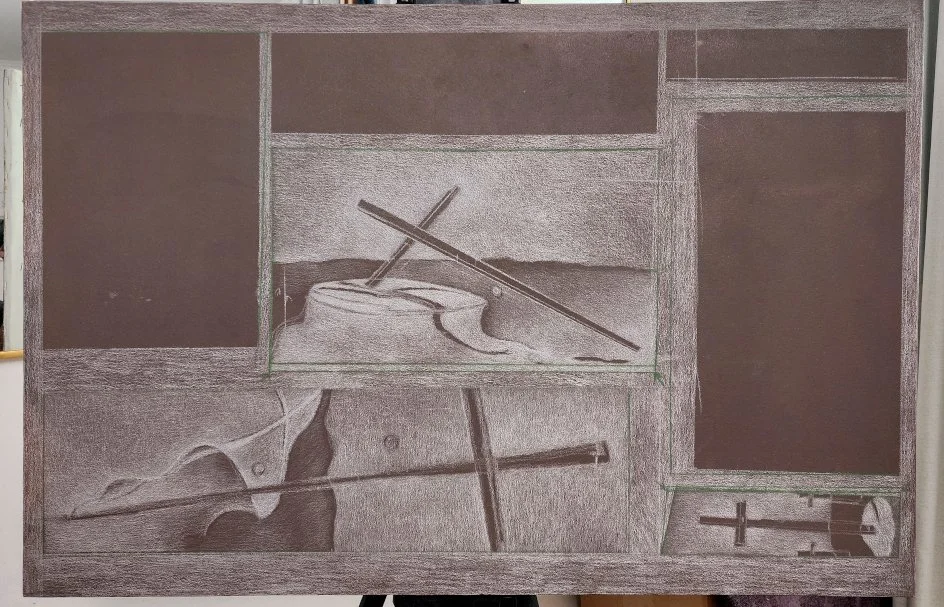The Joy of Rediscovering A Secret Weapon: My Proportional Divider
My proportional dividers which are made of bamboo.
I've always been a devoted fan of the grid method for laying out my foundational drawings. There's something deeply satisfying about that precise network of lines—turning one complex image into hundreds of manageable little drawings. It’s a process I find visually stimulating and gratifying.
However, my recent move to a smaller studio space, combined with tighter time constraints, has made my trusted grids impractical. Setting up chalk lines or wrestling with my unwieldy, long T-square is no longer the most convenient path to transferring drawings to my painting surface. Even just drawing freehand, while expressive, doesn't offer the same sense of structural precision that I crave. What a joy when I remembered an old friend tucked away in my toolbox:
The Proportional Divider
Scaling the printout of a drawing of crosses for a new painting.
The proportional divider is an adjustable instrument used to accurately transfer proportions from a source to a surface at a different scale, enabling enlargement or reduction without complex mathematical calculations.
For my new piece, Easter Mosaic 2, I'm transferring a drawing of five or six cross-compositions—which I think of as the individual "tiles" or tesserae of the mosaic—onto a single, large canvas. The original drawing is from an old sketchbook. I scanned the page, printed it on standard letter-size paper, and am now enlarging it onto the canvas before I begin painting.
Transferring the proportions of the drawing to the canvas.
Normally, I would use the grid method for this. However, considering available space, the intricate nature of setting up and executing the grid on both the canvas and the source image made that process seem overly labor-intensive. So, I reached for my proportional divider instead—and was instantly reminded of its magic.
Simple Yet Powerful
The fundamental concept of the proportional divider is simple, yet it is an immensely powerful tool. A perfect hybrid, it gives me the specificity and control I love about the grid method, yet allows me to retain the fluid expressiveness of drawing by hand. It’s the best of both worlds, and I’m thrilled to have it back in my hands.
For years, working in a large studio, I had acclimated to using projectors and a massive T-square—making gridding even my largest canvases a snap. But now, in a more compact space, that same equipment feels clumsy, especially on smaller canvases and panels. The proportional divider, by contrast, is self-contained, precise, and perfectly suited for this new reality.
Getting the Most from Your Proportional Divider
There are a few key practices that will ensure you get pinpoint accuracy while enjoying the creative process of using the divider. Simply put: you set the ratio on the tool by measuring a distance on your reference image with the small end, and the corresponding, scaled-up or scaled-down distance is instantly available at the larger end. The principle is that straightforward. To truly master it, here are two key tips to keep in mind:
1. Secure Your Setting: The First Rule of Measurement
Before you start, your tool must be trustworthy. The pivot point on your dividers—whether it's a tightening screw or a friction hinge—must be stiff enough to hold its position absolutely once you set it. There's nothing more frustrating than carefully measuring a distance on your reference image, only to have the arms shift slightly as you move to your canvas. This slippage introduces small errors that compound quickly, leading to an inaccurate drawing.
Before each use, check that your tool holds its setting firmly. If you have a screw, tighten it down securely. If it's a friction hinge, ensure it's not too loose. Your proportional divider should be an extension of your hand, not a source of insecurity.
2. Work in a "Single Glance" Zone
Arrange your workspace so that your reference image and final surface are as close together as possible. I place my sketch or photo right next to my canvas. This proximity allows me to keep the entire composition in my field of view with a single glance. It’s the secret sauce that makes the proportional divider such a powerful hybrid tool. Unlike a grid or projector, which can lock you into focusing on one square at a time, the divider forces you to constantly reference the whole—and keeping your surfaces close together is what amplifies this crucial benefit.
The drawing.
The canvas.
As I transfer key points, I find my artist's eye actively making micro-judgments about line, flow, and relationship. I become not just a technician copying points, but an artist re-drawing the image with guided precision. For me, this process is what keeps the final drawing feeling natural and alive, rather than stiff and sterile—a quality I find especially valuable in portraiture and figurative work, where a single millimeter can define an expression or alter a likeness.
So, if you find yourself constrained by space, time, budget, or simply longing for a more direct connection between your reference and your work, I urge you to give the proportional divider a try. It’s more than just a measuring device; it’s a bridge between precision and artistry.
I’d love to hear from you! Have you ever used a proportional divider? What’s your go-to method for transferring drawings when accuracy is key? Share your thoughts and message me here.




